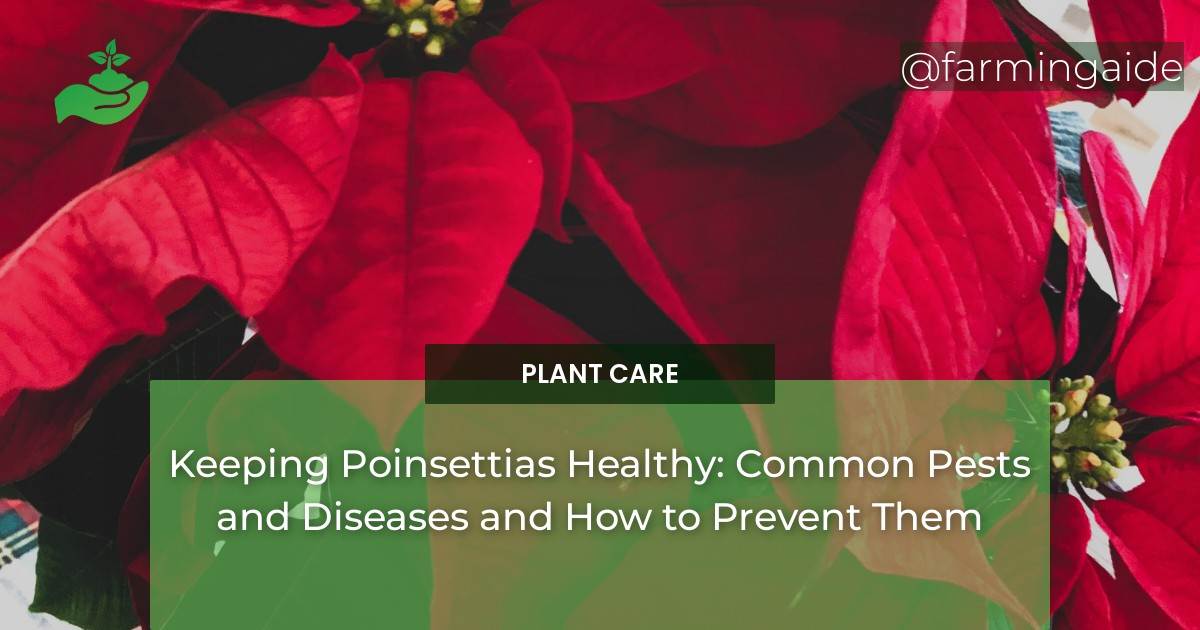Poinsettias are a popular and festive addition to any holiday decor, but they can also be a valuable addition to an urban farming or horticulture operation. However, like any plant, poinsettias are susceptible to pests and diseases that can quickly diminish their health and beauty. As a SEO Expert and Urban Farming and Horticulture Industry Expert, I have extensive knowledge of optimizing content for improved Page Rank and a deep understanding of all things related to plant selection and cultivation, soil management, pest and disease control, sustainable gardening practices, and seasonal planning and crop rotation.
In this comprehensive article, I will share my expertise on keeping poinsettias healthy by preventing and treating common pests and diseases. By following the strategies outlined in this article, you can ensure that your poinsettias remain vibrant and pest-free throughout the holiday season and beyond.
Identifying Common Pests and Diseases in Poinsettias
Poinsettias can be affected by a variety of pests and diseases, which can cause damage to the leaves, stems, and flowers. It is important to be able to identify these issues early on in order to prevent them from spreading and causing significant damage to the plant.
Pests
Some of the most common pests that can affect poinsettias include:
- Aphids
- Whiteflies
- Spider mites
- Thrips
- Mealybugs
These pests can cause damage to the leaves and stems of poinsettias, resulting in discoloration, wilting, and stunted growth. They can also attract other pests and diseases, making it important to address them as soon as they are identified.
Diseases
Common diseases that can affect poinsettias include:
- Root rot
- Leaf spot
- Powdery mildew
- Fungal leaf spots
- Viral infections
These diseases can cause discoloration, wilting, and even death of the plant if left untreated. They can also spread quickly to other plants, making it important to address them as soon as they are identified.
Prevention and Treatment Strategies for Poinsettia Pests and Diseases
Early detection and treatment are key to preventing and controlling pests and diseases in poinsettias. It is also important to use organic and natural methods whenever possible, as chemical treatments can be harmful to both the plant and the environment.
ALSO READ
Prevention Strategies
There are several steps you can take to prevent pests and diseases from affecting your poinsettias:
- Choose healthy plants from reputable sources
- Place poinsettias in an area with good air circulation and proper sunlight
- Use well-draining soil and avoid overwatering
- Rotate crops to prevent the buildup of pests and diseases in the soil
- Implement sustainable gardening practices, such as companion planting and using natural pest deterrents
Treatment Strategies
If pests or diseases do affect your poinsettias, there are natural and organic solutions that can be effective in controlling them:
- Neem oil spray for aphids, whiteflies, and spider mites
- Diatomaceous earth for thrips and mealybugs
- Copper fungicide for fungal diseases
- Pruning infected leaves and stems
If these methods are not effective, chemical treatments may be necessary. However, it is important to carefully follow label instructions and take proper safety precautions when using these products.
Seasonal Planning and Crop Rotation for Poinsettia Health
In addition to prevention and treatment strategies, seasonal planning and crop rotation can also play a significant role in keeping poinsettias healthy. By rotating crops and planning ahead for the growing season, you can prevent the buildup of pests and diseases in the soil and ensure that your poinsettias have the best chance of thriving.
For example, a crop rotation plan for poinsettias could include alternating with plants that are known to repel pests, such as marigolds or chrysanthemums. This can help to naturally deter pests and reduce the risk of infestations.
What Pests and Diseases Should I Watch Out for When Growing Poinsettias?
When growing poinsettias, it is essential to be aware of certain pests and diseases that can affect these beautiful plants. Aphids, whiteflies, and spider mites are common pests that can harm poinsettias. Keep an eye out for symptoms of powdery mildew and root rot, as these diseases can weaken the plants. Regularly inspect your poinsettias and take prompt action to control these issues. Remember, understanding how to care for poinsettias includes safeguarding them against potential threats.
Conclusion
In conclusion, poinsettias are a beautiful and festive addition to any urban farming or horticulture operation, but they can be susceptible to pests and diseases. By being proactive in prevention and treatment, implementing sustainable gardening practices, and planning ahead for the growing season, you can keep your poinsettias healthy and vibrant. Remember to always monitor your plants for any signs of pests or diseases and take immediate action to prevent them from spreading. With these strategies in place, you can enjoy healthy and pest-free poinsettias year after year.


